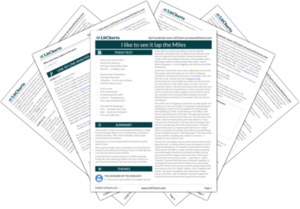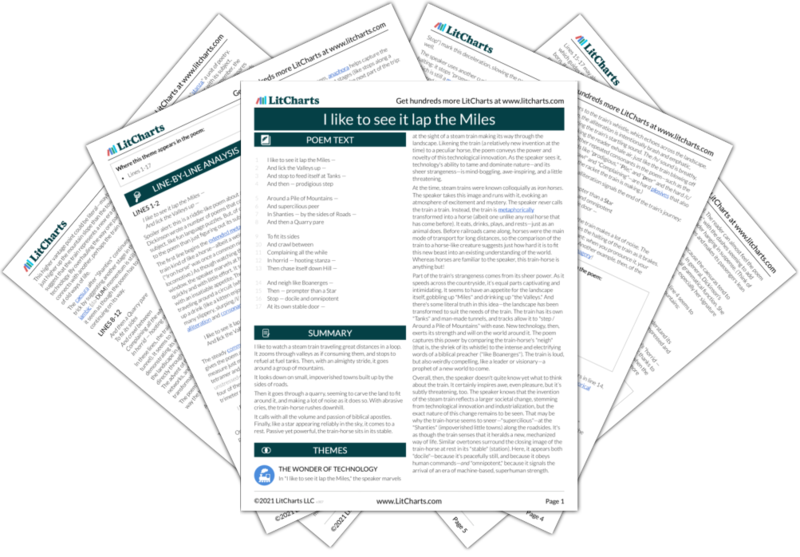I like to see it lap the Miles Summary & Analysis

Download this entire guide to “I like to see it lap the Miles” as a printable PDF. Download this LitChart! (PDF)
Question about this poem?
Have a question about this poem?
Have a specific question about this poem?
Have a specific question about this poem?
Have a specific question about this poem?
A LitCharts expert can help.
A LitCharts expert can help.
A LitCharts expert can help.
A LitCharts expert can help.
A LitCharts expert can help.
Ask a question
Ask a question
Ask a question
Emily Dickinson wrote "I like to see it lap the Miles" sometime between 1858 and 1862. The poem describes a steam train as it travels through the surrounding landscape. Imagining the train as a giant horse, the speaker marvels at its wild and unrivaled strength, speed, and power. The poem never explicitly names its main subject, taking on a riddle-like quality also found in Dickinson poems like "A Route of Evanescence" and "A Narrow Fellow in the Grass."

Get the entire guide to “I like to see it lap the Miles” as a printable PDF.
The Full Text of “I like to see it lap the Miles”
1 I like to see it lap the Miles —
2 And lick the Valleys up —
3 And stop to feed itself at Tanks —
4 And then — prodigious step
5 Around a Pile of Mountains —
6 And supercilious peer
7 In Shanties — by the sides of Roads —
8 And then a Quarry pare
9 To fit its sides
10 And crawl between
11 Complaining all the while
12 In horrid — hooting stanza —
13 Then chase itself down Hill —
14 And neigh like Boanerges —
15 Then — prompter than a Star
16 Stop — docile and omnipotent
17 At its own stable door —
The Full Text of “I like to see it lap the Miles”
1 I like to see it lap the Miles —
2 And lick the Valleys up —
3 And stop to feed itself at Tanks —
4 And then — prodigious step
5 Around a Pile of Mountains —
6 And supercilious peer
7 In Shanties — by the sides of Roads —
8 And then a Quarry pare
9 To fit its sides
10 And crawl between
11 Complaining all the while
12 In horrid — hooting stanza —
13 Then chase itself down Hill —
14 And neigh like Boanerges —
15 Then — prompter than a Star
16 Stop — docile and omnipotent
17 At its own stable door —
“I like to see it lap the Miles” Summary
“I like to see it lap the Miles” Themes

The Wonder of Technology
- See where this theme is active in the poem.
Line-by-Line Explanation & Analysis of “I like to see it lap the Miles”
Lines 1-2
I like to see it lap the Miles —
And lick the Valleys up —




Lines 3-5
And stop to feed itself at Tanks —
And then — prodigious step
Around a Pile of Mountains —




Lines 6-7
And supercilious peer
In Shanties — by the sides of Roads —




Lines 8-12
And then a Quarry pare
To fit its sides
And crawl between
Complaining all the while
In horrid — hooting stanza —




Lines 13-14
Then chase itself down Hill —
And neigh like Boanerges —




Lines 15-17
Then — prompter than a Star
Stop — docile and omnipotent
At its own stable door —




“I like to see it lap the Miles” Poetic Devices & Figurative Language
Alliteration




- See where this poetic device appears in the poem.
Allusion




- See where this poetic device appears in the poem.
Anaphora




- See where this poetic device appears in the poem.
Caesura




- See where this poetic device appears in the poem.
Consonance




- See where this poetic device appears in the poem.
Enjambment




- See where this poetic device appears in the poem.
Extended Metaphor




- See where this poetic device appears in the poem.
Simile




- See where this poetic device appears in the poem.
“I like to see it lap the Miles” Vocabulary
- Lap
- Tanks
- Prodigious
- Supercilious
- Peer
- Shanties
- Quarry
- Pare
- Boanerges
- Prompter
- Docile
- Omnipotent
- Stable
- See where this vocabulary word appears in the poem.
Form, Meter, & Rhyme Scheme of “I like to see it lap the Miles”
Form
Meter
Rhyme Scheme
“I like to see it lap the Miles” Speaker
“I like to see it lap the Miles” Setting
Literary and Historical Context of “I like to see it lap the Miles”
More “I like to see it lap the Miles” Resources
External Resources
- In Our Time Podcast — Experts talk about Emily Dickinson's life and work on the BBC's In Our Time podcast/radio show.
- Dickinson's Biography — A valuable Dickinson resource from the Poetry Foundation.
- A History of the Steam Train — A look at the story behind this much-loved mode of transport.
- The Dickinson Museum — The Emily Dickinson Museum, situated in the poet's old house, offers many resources for students.
- A Dickinson Documentary — Watch a short educational film on Dickinson's life and poetry.
LitCharts on Other Poems by Emily Dickinson
- A Bird, came down the Walk
- After great pain, a formal feeling comes –
- A Light exists in Spring
- A Murmur in the Trees—to note—
- A narrow Fellow in the Grass
- An awful Tempest mashed the air—
- As imperceptibly as grief
- A still—Volcano—Life—
- Because I could not stop for Death —
- Before I got my eye put out
- Fame is a fickle food
- Hope is the thing with feathers
- I cannot live with You –
- I cautious, scanned my little life
- I could bring You Jewels—had I a mind to—
- I did not reach Thee
- I died for Beauty—but was scarce
- I dreaded that first Robin, so
- I dwell in Possibility –
- I felt a Funeral, in my Brain
- If I can stop one heart from breaking
- I had been hungry, all the Years
- I have a Bird in spring
- I heard a Fly buzz - when I died -
- I like a look of Agony
- I measure every Grief I meet
- I’m Nobody! Who are you?
- I started Early — Took my Dog —
- I taste a liquor never brewed
- It was not Death, for I stood up
- I—Years—had been—from Home—
- Like Rain it sounded till it curved
- Much Madness is divinest Sense -
- My Life had stood - a Loaded Gun
- Nature is what we see
- One need not be a Chamber — to be Haunted
- Publication — is the Auction
- Safe in their Alabaster Chambers
- Shipwreck
- Success is counted sweetest
- Tell all the truth but tell it slant —
- The Brain—is wider than the Sky—
- The Bustle in a House
- The Mushroom is the Elf of Plants
- There came a Wind like a Bugle
- There is no Frigate like a Book
- There's a certain Slant of light
- There's been a Death, in the Opposite House
- The saddest noise, the sweetest noise
- The Sky is low — the Clouds are mean
- The Soul has bandaged moments
- The Soul selects her own Society
- The Wind – tapped like a tired Man –
- They shut me up in Prose –
- This is my letter to the world
- This World is not Conclusion
- 'Twas the old—road—through pain—
- We grow accustomed to the Dark
- What mystery pervades a well!
- Whose cheek is this?
- Wild nights - Wild nights!
Cite This Page
Definition
I like to see it lap the Miles
Full Text
1 I like to see it lap the Miles —
2 And lick the Valleys up —
3 And stop to feed itself at Tanks —
4 And then — prodigious step
5 Around a Pile of Mountains —
6 And supercilious peer
7 In Shanties — by the sides of Roads —
8 And then a Quarry pare
9 To fit its sides
10 And crawl between
11 Complaining all the while
12 In horrid — hooting stanza —
13 Then chase itself down Hill —
14 And neigh like Boanerges —
15 Then — prompter than a Star
16 Stop — docile and omnipotent
17 At its own stable door —
Lines 3-4
It gathers to a greatness, like the ooze of oil Crushed
Get instant explanations to your questions about anything we cover.
Powered by LitCharts content and AI.
Copyright © 2024 All Rights Reserved
Save time. Stress less.
AI Tools for on-demand study help and teaching prep.
 Quote explanations, with page numbers, for over 44,163 quotes.
Quote explanations, with page numbers, for over 44,163 quotes.
 PDF downloads of all 1,996 LitCharts guides.
PDF downloads of all 1,996 LitCharts guides.
 Expert analysis to take your reading to the next level.
Expert analysis to take your reading to the next level.
 Advanced search to help you find exactly what you're looking for.
Advanced search to help you find exactly what you're looking for.
 Expert analysis to take your reading to the next level.
Expert analysis to take your reading to the next level. Advanced search to help you find exactly what you're looking for.
Advanced search to help you find exactly what you're looking for.





























































 Quote explanations, with page numbers, for over 44,163 quotes.
Quote explanations, with page numbers, for over 44,163 quotes. PDF downloads of all 1,996 LitCharts guides.
PDF downloads of all 1,996 LitCharts guides. Expert analysis to take your reading to the next level.
Expert analysis to take your reading to the next level. Advanced search to help you find exactly what you're looking for.
Advanced search to help you find exactly what you're looking for.
 Expert analysis to take your reading to the next level.
Expert analysis to take your reading to the next level. Advanced search to help you find exactly what you're looking for.
Advanced search to help you find exactly what you're looking for.